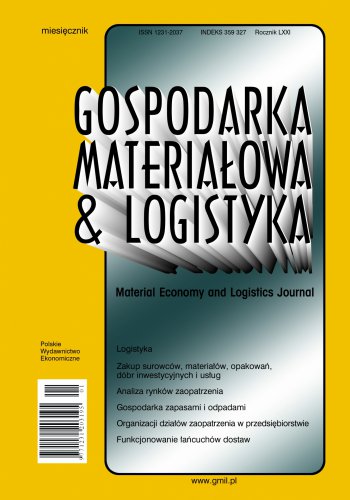Dynamika kształtowania więzi sieciowych w łańcuchu dostaw. Perspektywa triadyczna
Jedną z istotnych przesłanek kształtowania powiązań sieciowych w łańcuchu dostaw jest koncentracja podmiotów (tzw. uczestników głównych) na kluczowych kompetencjach i zlecanie pozostałych usług podmiotom trzecim (usługodawcom). W rezultacie między ogniwami łańcucha dostaw dochodzi do nawiązania relacji wielokrotnych, z kilkoma podmiotami jednocześnie. W literaturze przedmiotu do zilustrowania relacji sieciowych w łańcuchu dostaw wykorzystuje się koncepcję triady. Niemniej obraz ten ma na ogół charakter statyczny, nie ukazuje bowiem rzeczywistej dynamiki formowania takiej relacji w świetle teorii kapitału społecznego, w centrum której znajduje się struktura triadyczna. Celem artykułu jest rozpoznanie i omówienie etapów dynamiki wyłaniania powiązań sieciowych w łańcuchu dostaw za pomocą przechodniej triady sfery usług. Triada przechodnia obejmuje trzy podmioty (dostawcę, odbiorcę oraz usługodawcę), które nawiązują między sobą trzy powiązania diadyczne.
Bibliografia
Bibliografia/References
Achrol, R. S. (1997). Changes in the theory of interorganizational relations in marketing: towards a network paradigm. Journal of the Academy of Marketing Science, 25(1), 56–71. https://doi.org/10.1007/bf02894509
Ballou, R. H. (2004). Business Logistics/ Supply Chain Management. 5th ed. New Jersey: Prentice Hall.
Barratt, M. (2004). Understanding the meaning of collaboration in the supply chain, Supply Chain Management: An International Journal, 9(1), 30–42. https://doi.org/10.1108/13598540410517566
Burt, R. S. (2017). Structural holes versus network closure as social capital. New York: Routledge.
Chae, S. (2018). Horizontal versus vertical structural holes in supply networks: Contrasting performance implications for focal firms, Proceedings of the 20th EurOMA Conference, 24–26 June, Budapest.
Choi, T. Y., Wu, Z. (2009a): Triads in supply networks: theorizing buyer-supplier-supplier relationships. Journal of Supply Chain Management, 45(1), 8–25. https://doi.org/10.1111/j.1745-493x.2009.03151.x
Choi, T. Y., Wu, Z. (2009b). Taking the leap from dyads to triads: buyer-supplier relationships in supply networks. Journal of Purchasing and Supply Management, 15(4), 263–266. https://doi.org/10.1016/j.pursup.2009.08.003
Coleman, J. (1990). Foundations of social theory. Cambridge: Harvard University Press.
Dubois, A. (2009). Comment on "Taking the leap from dyads to triads: buyer-supplier relationships in supply networks" by Choi and Wu — To leap or not to leap: triads as arbitrary subsets of networks of connected dyads. Journal of Purchasing & Supply Management, 15, 267–268. https://doi.org/10.1016/j.pursup.2009.08.003
Finne, M., Holmström J. (2013). A manufacturer moving upstream: triadic collaboration for service delivery. Supply Chain Management: An International Journal, 18(1), 21–33. https://doi.org/10.1108/13598541311293159
Hirschheim, R., Lacity, M. (2000). The Myths and Realities of Information Technology Insourcing. Communications of the ACM, 43(2), 99–107. https://doi.org/10.1145/328236.328112
Karatzas, A., Johnson, M., Bastl, M. (2017). Manufacturer–supplier relationships and service performance in service triads. International Journal of Operations & Production Management, 37(7), 950–969. https://doi.org/10.1108/ijopm-11-2015-0719
Krackhardt, D. (1999). The ties that torture: simmelian tie analysis in organizations. Research in the Sociology of Organizations, 16(1), 183–210.
Li, M., Choi, T. Y. (2009). Triads in service outsourcing: bridge, bridge decay and bridge transfer. Journal of Supply Chain Management, 45(3), 27–39. https://doi.org/10.1111/j.1745-493x.2009.03169.x
Liker, J., Choi, T. (2004). Building Deep Supplier Relationships. Harvard Business Review, 82(12), 104–113.
Madhavan, R., Gnyawali, D., He, J. (2004). Two's company, three's a crowd? Triads in cooperative-competitive networks. Academy of Management Journal, 47(6), 918–927. https://doi.org/10.5465/20159631
Mentzer, J. T., Stank, T. P., Myers, M. B. (2007). Why global supply chain management? Global Supply Chain Management, Thousand Oaks: SAGE Publications. https://doi.org/10.4135/9781412976169.n1
Obstfeld, D. (2005). Social networks, the tertius iungens orientation, and involvement in innovation. Administrative Science Quarterly, 50 (1), 100–130. https://doi.org/10.2189/asqu.2005.50.1.100
Obstfeld, D., Borgatti, S. P., Davis, J. P. (2014). Brokerage as a process: decoupling third party action from social network structure. W: S. P. Borgatti, D. J. Brass, D. S. Halgin, G. Labianca, A. Mehra (red.), Contemporary perspectives on organizational social networks. Cambridge: Emerald. https://doi.org/10.1108/s0733-558x(2014)0000040007
Portier, P. Pardo, C., Salle, R. (2014). From dyad to triad: managing differentiated vs. undifferentiated relationships, 30th IMP Conference, Bordeaux.
Sampson, S. (2000). Customer-supplier duality and bi-directional supply chains in service organizations. International Journal of Service Industry Management, 11(4), 348–364. https://doi.org/10.1108/09564230010355377
Schreiner, A. (2015). Triadic analysis of business relationship's ending: a case study of a dyad and a third actor. Journal of Business & Industrial Marketing, 30(8), 891–905. https://doi.org/10.1108/jbim-01-2014-0023
Simmel, G. (1950). The sociology of Georg Simmel. New York: Free Press.
Świerczek, A. (2005). Elektroniczne łańcuchy dostaw. Gospodarka Materiałowa i Logistyka, (4), 6–12.
Świerczek, A. (2006). Znaczenie sieci informacyjnej w kształtowaniu organizacji sieciowej. Gospodarka Materiałowa i Logistyka, (6), 16–22.
Świerczek, A. (2012). Zarządzanie ryzykiem transmisji zakłóceń we współdziałaniu przedsiębiorstw w łańcuchach dostaw. Katowice: UE w Katowicach.
Świerczek, A. (2019a). Zarządzanie łańcuchem dostaw w ujęciu zintegrowanym. Warszawa: PWE.
Świerczek, A. (2019b). Manufacturer structural embeddedness and the network rent: the intervening role of relational embeddedness in the triadic supply chains. Supply Chain Management: An International Journal, 24(3), 334–354. https://doi.org/10.1108/scm-06-2018-0232
Świerczek, A. (2020a). Rezylientne łańcuchy dostaw jako złożone systemy adaptacyjne. Warszawa: PWE.
Świerczek, A. (2020b). Relational orientation of triadic supply chains with structural holes: an empirical comparison of rents derived from bridging the structural holes. Supply Chain Management: An International Journal, 25(5), 565–583. https://doi.org/10.1108/scm-10-2019-0382
Świerczek, A. (2020c). Conceptualizing the role of embeddedness in deriving the network competitive advantage of triadic supply chains. Gospodarka Materiałowa i Logistyka, (1), 2–10. https://doi.org/10.33226/1231-2037.2020.1.1
Wynstra, F., Spring, M., Schoenherr, T. (2015). Service triads: a research agenda for buyer-supplier-customer triads in business services, Journal of Operations Management, 35, 1–20. https://doi.org/10.1016/j.jom.2014.10.002
Zhang, J. J., Lawrence, B., Anderson, C. K. (2015). An agency perspective on service triads: linking operational and financial performance, Journal of Operations Management, 35(3), 56–66. https://doi.org/10.1016/j.jom.2014.10.005

